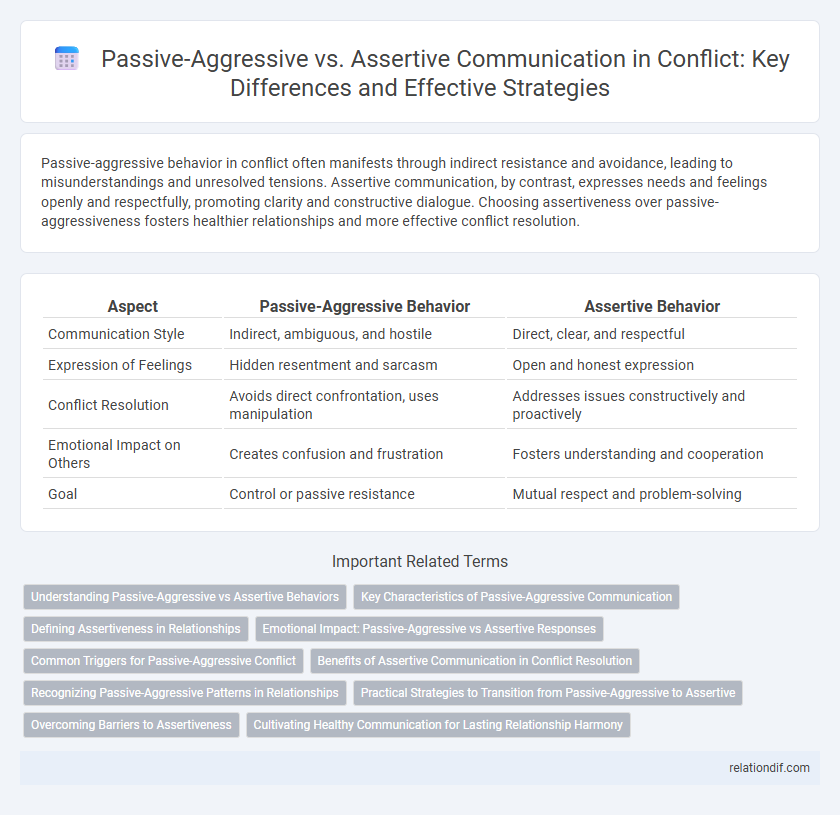Passive-aggressive behavior in conflict often manifests through indirect resistance and avoidance, leading to misunderstandings and unresolved tensions. Assertive communication, by contrast, expresses needs and feelings openly and respectfully, promoting clarity and constructive dialogue. Choosing assertiveness over passive-aggressiveness fosters healthier relationships and more effective conflict resolution.
Table of Comparison
| Aspect | Passive-Aggressive Behavior | Assertive Behavior |
|---|---|---|
| Communication Style | Indirect, ambiguous, and hostile | Direct, clear, and respectful |
| Expression of Feelings | Hidden resentment and sarcasm | Open and honest expression |
| Conflict Resolution | Avoids direct confrontation, uses manipulation | Addresses issues constructively and proactively |
| Emotional Impact on Others | Creates confusion and frustration | Fosters understanding and cooperation |
| Goal | Control or passive resistance | Mutual respect and problem-solving |
Understanding Passive-Aggressive vs Assertive Behaviors
Passive-aggressive behavior manifests through indirect resistance and subtle hostility, often leading to misunderstandings and unresolved conflict. Assertive behavior, characterized by clear, honest, and respectful communication, promotes effective conflict resolution and mutual understanding. Recognizing these contrasting behaviors is essential for managing interpersonal dynamics and fostering healthier relationships.
Key Characteristics of Passive-Aggressive Communication
Passive-aggressive communication is characterized by indirect resistance, subtle sarcasm, and intentional procrastination that undermine clear expression of feelings or needs. Individuals often avoid open confrontation, instead exhibiting behaviors such as backhanded compliments, silent treatment, or intentional inefficiency. This indirect approach contrasts sharply with assertive communication, which emphasizes honesty, clarity, and respectful expression of thoughts and emotions.
Defining Assertiveness in Relationships
Assertiveness in relationships involves expressing thoughts, feelings, and needs openly and respectfully without infringing on others' rights. Unlike passive-aggressive behavior, which hides true emotions behind indirect actions or sarcasm, assertiveness promotes clear communication and mutual understanding. Developing assertiveness enhances emotional honesty and helps resolve conflicts constructively, fostering healthier interactions.
Emotional Impact: Passive-Aggressive vs Assertive Responses
Passive-aggressive responses often generate confusion, resentment, and prolonged tension by masking true feelings in indirect communication. Assertive responses promote emotional clarity and mutual respect, fostering healthier conflict resolution and reducing misunderstandings. Emotional impact is critical; assertiveness supports psychological well-being and relationship trust, while passive-aggressiveness may exacerbate stress and emotional distance.
Common Triggers for Passive-Aggressive Conflict
Common triggers for passive-aggressive conflict often stem from feelings of frustration, fear of confrontation, or perceived unfair treatment. Situations involving unclear communication, unmet expectations, or power imbalances frequently ignite passive-aggressive responses. Recognizing signs such as sarcasm, silent treatment, or indirect criticism is essential for addressing underlying tensions effectively.
Benefits of Assertive Communication in Conflict Resolution
Assertive communication in conflict resolution fosters clear expression of needs and boundaries, reducing misunderstandings and resentment. It promotes mutual respect and encourages constructive dialogue, leading to more effective problem-solving and stronger relationships. By contrast, passive-aggressive behavior often perpetuates tension and undermines trust, hindering resolution efforts.
Recognizing Passive-Aggressive Patterns in Relationships
Recognizing passive-aggressive patterns in relationships involves identifying indirect expressions of hostility, such as sarcasm, procrastination, or silent treatment, which undermine honest communication. These behaviors create confusion and resentment by masking true feelings, hindering conflict resolution and emotional intimacy. Addressing passive-aggressive actions requires awareness and clear boundary-setting to foster assertive, transparent dialogue and healthier interactions.
Practical Strategies to Transition from Passive-Aggressive to Assertive
Recognizing passive-aggressive patterns, such as indirect communication and subtle resistance, is crucial for cultivating assertiveness by openly expressing thoughts and needs with clarity. Practicing "I" statements and setting clear boundaries fosters respectful dialogue, reducing misunderstandings and escalating tensions. Regular self-reflection combined with seeking feedback from trusted peers enhances emotional regulation and strengthens assertive conflict resolution skills.
Overcoming Barriers to Assertiveness
Overcoming barriers to assertiveness requires recognizing passive-aggressive behaviors that mask unresolved conflicts and hinder effective communication. Developing clear, direct expressions of needs and feelings promotes mutual respect and reduces misunderstandings in interpersonal relationships. Consistent practice of assertive communication skills enables individuals to navigate conflicts constructively and fosters healthier, more transparent interactions.
Cultivating Healthy Communication for Lasting Relationship Harmony
Passive-aggressive behavior undermines trust and fosters resentment, while assertive communication promotes clarity and mutual respect in relationships. Cultivating healthy communication involves expressing needs and boundaries honestly and empathetically, which reduces misunderstandings and strengthens emotional connections. Prioritizing assertiveness over passive-aggressiveness supports lasting harmony and conflict resolution in intimate partnerships.
passive-aggressive vs assertive Infographic

 relationdif.com
relationdif.com